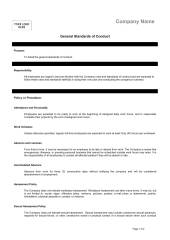|
Representation: |
PJ Radich, K Spackman ; BA Buckett |
|
Abstract: |
This was an unsuccessful challenge by the plaintiff to a determination of the Employment Relations Authority which held that the defendant’s dismissal was unjustified and an unsuccessful cross-challenge by the defendant involving allegations that the plaintiff had breached its common law and statutory obligations. The defendant was employed by the plaintiff as a Principal Corrections Officer. A prisoner asked the defendant to bring contraband into the prison. The defendant refused and ordered the prisoner to leave his office. The defendant followed the prisoner out of the office. As the defendant and prisoner exited the office, another officer believed the prisoner was going to attack the defendant and initiated control and restraint on the prisoner. A Unit Manager conducted an initial inquiry and concluded it was probable the defendant had assaulted the prisoner prior to the control and restraint. The defendant was suspended. The defendant said that he had placed his hand on the prisoner’s shoulder to guide him but denied striking the prisoner. The prisoner did not originally complain of an assault prior to the control and restraint. An investigation was commenced and a number of interviews were held. The investigator found on a preliminary basis that the defendant was guilty of serious misconduct and should be dismissed (“the investigation report”). After receiving the investigation report, viewing the video footage and following a series of meetings in which the defendant’s representatives made submissions, the regional manager dismissed the defendant. The defendant submitted that there were a number of procedural flaws in the investigation, including that the defendant was not given proper notice of the specific allegations against him and that the regional manager had formed an unwavering view based on the investigation report and had refused to consider alternative interpretations. Held (1) The employer’s actions are measured against the standard of what a fair and reasonable employer would have done in all the circumstances. This refers to a fair and reasonable employer in the position of the plaintiff. This approach is similar to the way the standard of care is assessed in the common law of negligence which acknowledges the reasonable skill and knowledge of a person in the position of the defendant. (para 9) (2) In assessing generally whether the actions of an employer were fair and reasonable, relevant factors are the size of the workplace and the number of employees employed, the nature and quality of the resources available to the employer including access to specialist human resources advice, and any other statutory or public interest obligations on the employer. Because of its particular characteristics and legislative and policy obligations, the plaintiff was obliged to act with a high standard of fairness and reasonableness. (paras 11, 144) (3) The mere application of force by a prison officer on a prisoner does not establish serious misconduct. In order to assess whether it is justified the decision maker must properly inquire into the state of mind of the officer at the time the physical force was used. There was no consideration in the employment investigation or the preliminary findings of the defendant’s reasons for acting as they found he had. (paras 146, 150) (4) The employment investigation was not conducted fairly. It was in breach of the plaintiff’s policy requiring investigations to be procedurally fair by informing the employee of the details of the allegations and evidence against him. It did not afford him a real opportunity to explain and the regional manager closed his mind to any alternative explanation. (paras 132, 155) (5) The decision to dismiss would not have been a reasonable response even if the defendant had used the physical force as alleged. That was because of the defendant’s description of the attitude of the prisoner. There was a strong possibility that the prisoner was passively resisting the defendant’s instruction. It was, therefore, reasonably open to a fair-minded employer to conclude that even if the alleged application of force by the defendant occurred it was in circumstances which did not justify dismissal. The regional manager may have reasonably concluded there had been breaches of the code of conduct but not serious misconduct. (paras 157-160) (6) In the light of the outcome of the challenge it was not necessary to discuss the cross-challenge in any detail except to note that on the evidence none of the cross challenges would have been made out. In addition, although the Court found that the plaintiff unjustifiably dismissed the defendant, there was no evidence that in doing so it was in breach of any statutory or contractual obligation to the extent that warranted any penalty. (para 5) |
|
Result: |
Challenge dismissed ; Cross-challenge dismissed ; Remedies deferred until further hearing ; Costs reserved |
|
Appeal: |
This was an unsuccessful challenge to a determination of the Employment Relations Authority unreported, GJ Wood, 13 August 2007, WA 111/07 |
|
Statutes: |
Corrections Act 2004 s83 ; ERA s4(1A) ; ERA s103A |
|
Cases Cited: |
Air New Zealand Ltd v Hudson [2006] 1 ERNZ 415 ; Bolam v Friern Hospital Management Committee [1957] 1 WLR 582 ; Hamilton v Papakura District Council [2000] 1 NZLR 265 ; Lawless v Comvita New Zealand Ltd [2005] ERNZ 861 ; NZ (with exceptions) Food Processing IUOW v Unilever New Zealand Ltd [1990] 1 NZILR 35 ; NZ (with exceptions) Shipwrights Union v Honda NZ Ltd [1989] 3 NZILR 82 ; Timu v Waitemata District Health Board [2007] ERNZ 419 ; Whitehouse v Jordan [1981] 1 WLR 246 ; X v Auckland District Health Board [2007] ERNZ 66 |



